Remember you have to be a member of the N Gauge Society to purchase our kits
Kit 20: BR ‘Anhydrite’ Hopper
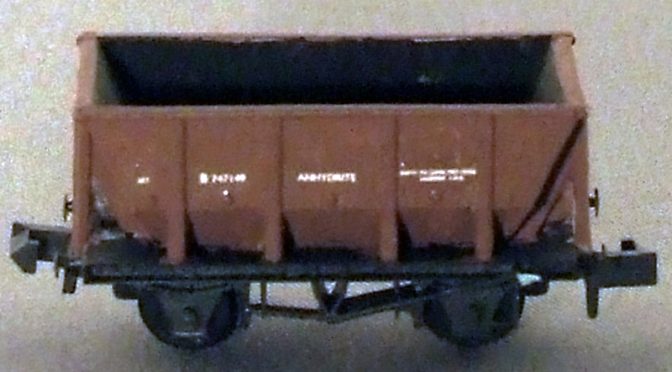
- NGSK0200
- era 4-7
- decals NGST0200
- kit difficulty beginner
- etch difficulty advanced
In 1954 BR built 150 of these 25-ton anhydrite hoppers to diagram D1/179 for traffic from the Long Meg quarry on the Settle and Carlisle line. They lasted until the early 80s. It is a very simple kit to make, fitting on the supplied Peco 10 ft chassis.
Kit 21: SR/BR 12t Box Vans Twin Pack
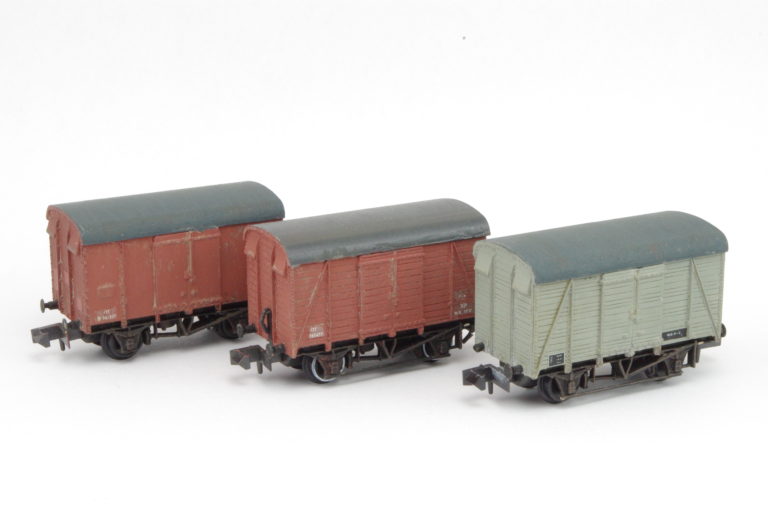
- NGSK0210
- era 3-5
- decals NGST0210
- difficulty beginner
Sufficient parts are included in each kit to allow the construction of two of three different variants: equal width planking on both ends and sides; unequal width planking on both ends and sides; and plywood sides and ends. This kit is produced in plastic and assembly is straightforward. Minor modification is required to the chassis before fitting to respective bodies, but this should be well within the average modeller’s capabilities.
This is the standard Southern Railway goods van with a 10 foot wheelbase and distinctive elliptical roof. About 1000 fitted vans were built 1936-38 with even planked sides, then 1936-42 another 1800 with uneven planked sides. Between 1942-4 the SR built unfitted vans with uneven planked sides on behalf of three companies: SR 1300, GWR 650, and LMS 400. Most were fitted after the war. From 1945-49 ply sides were used with 1,800 fitted vans built by SR/BR. The kit could easily be adapted to represent over 2000 vans built between 1927 and 1935 with the same even planked body but a 9 foot chassis.
Kit 22: BR ‘Shark’ Ballast Plough Brake
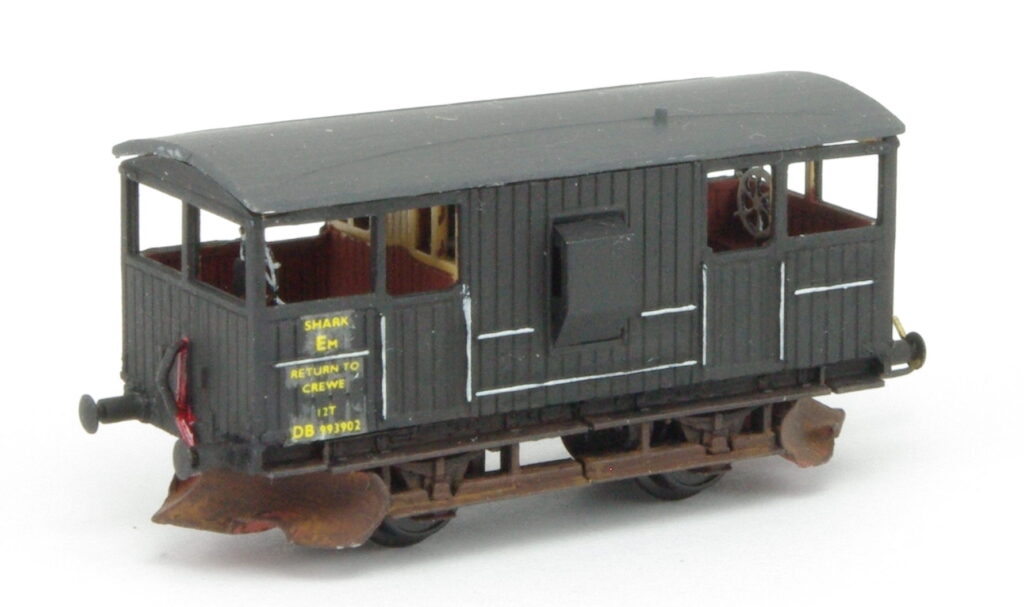
- NGSK0220
- era 4-9
- decals=NGST0220
- difficulty intermediate
The main kit parts for the body are produced in plastic with white metal castings for the ploughs and brass etches for the plough shields and operating handwheels. Assembly is therefore relatively straightforward though some quite extensive modification is required to the Peco guards van chassis provided. This kit must therefore be considered only suitable for those with some experience in wagon kit construction.
BR built over 200 of these brake vans between 1951 and 1960. Vital to any permanent way ballast train, in addition to acting as a brake van it could spread the ballast discharged from the wagons by the use of special ploughs mounted underneath the veranda ends. It was common to have a Shark on each end of a train of ballast hoppers. While no longer needed as brake vans, some are still in use in 2020 as ploughs, and in the intervening years have received an enormous variety of liveries, reflected in the number of different markings provided on the associated sheet of decals.
Kit 23: RCH/LMS 12t Open Wagon
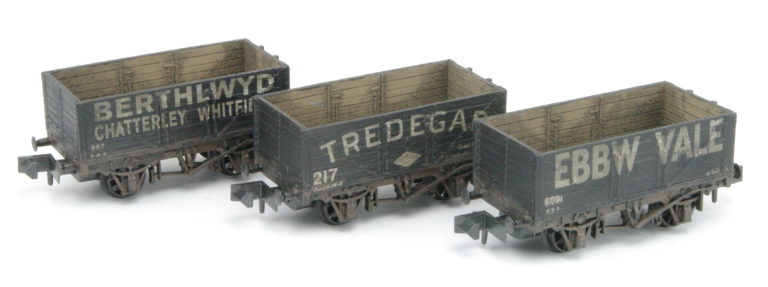
- NGSK0230
- era 3-6
- decals=Robbies Rolling Stock
- NGST0230 for additional BR markings
- difficulty beginners
The prototype for this model was a wagon built in its thousands to a standard design of the RCH (Railway Clearing House) for use by the many private traders of the time. Obviously “many traders” means many liveries, and this kit is therefore the perfect model for carrying these, often very colourful, liveries.
The kit is of all plastic construction and is designed to be a direct fit on to the Peco 9ft wheelbase chassis provided. It is therefore eminently suitable for newcomers to model wagon construction. Alternative fixed ends are included in the kit to enable wagons without end doors to be represented. After the formation of British Railways they were absorbed and renumbered with P prefixed numbers.
Kit 24: BR Standard Horsebox
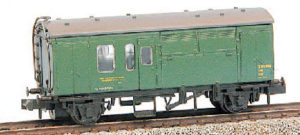
- NGSK0240
- era 4-5
- decals NGST 0240
- difficulty beginners
No model of this type of vehicle having ever been available in N Gauge, the Society decided to produce this model as a memorial to the late Andrew Calvert, our former Wagon Projects Officer, who passed away in November 2002. Because of the number of parts in this kit it should be considered a model for those with some previous experience in building model wagon kits.
Following the 1948 nationalisation, the fledgling British Railways inherited large numbers of horseboxes of various designs, many dating from the pre-grouping period. To replace them, at first, BR built horseboxes to existing LMS or LNER drawings, but by the mid-1950s the decision was taken to produce a totally new vehicle, based on Mk.1 carriages then on the drawing board. In all, 115 BR Mk.1 Standard Horseboxes were built in 1957 and 1958.
Kit 26: GWR Planked, Plywood & MOGO Vans
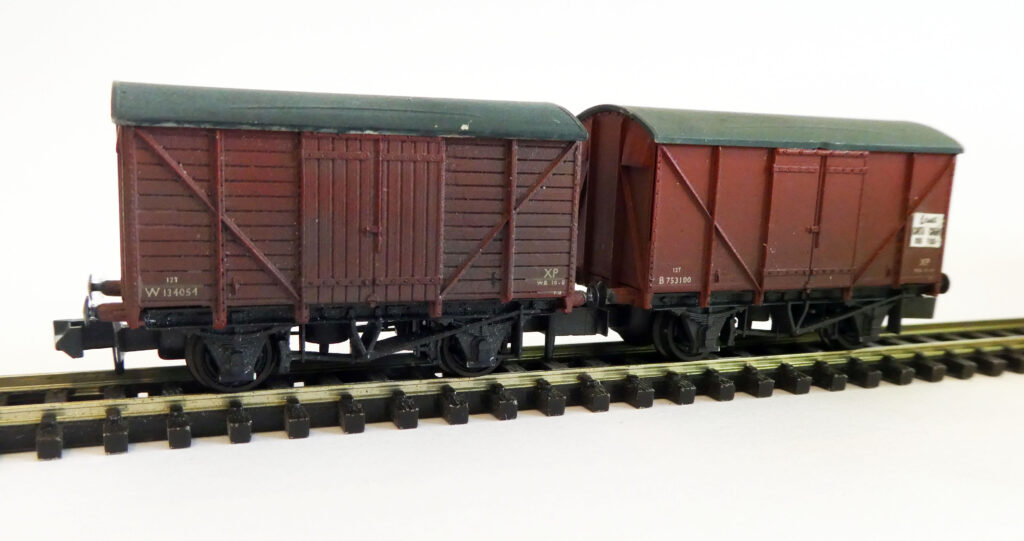
- NGSK0260
- era 3-6
- decals NGST 0260
- difficulty intermediate
From 1933 the GWR built more than 6000 ventilated vans with planked sides to designs V23 (fitted) and V24/34 (unfitted). A further 266 were built as PARTO vans to design V26, these having internal partitions to protect loads (e.g. biscuits) from being damaged during shunting. The GWR built 800 ventilated vans with plywood sides to design V36 (fitted) and V37 (unfitted) before nationalisation, with BR adding a further 330 following nationalisation. In 1935 the GWR built 350 MOGO (Motorcar Goods) wagons to design G31. These vehicles were almost identical to design V23 vans, except that they had doors built in the ends to facilitate loading of motor cars.
In 1947 a further 100 were built with plywood sides to a design G43, but these had planked ends. In service, unfitted vans were always common user (i.e shared between companies), with the fitted vans becoming common user from 1939. MOGOs do not appear to have ever been common user vehicles and were used mainly for sending new vehicles from factories to distributors, these being replaced by Carflats in the 1960s. This is an all plastic kit and features two different pairs of sides and three different pairs of ends, thus enabling models of any two of the prototypes to be built. Two Peco 10ft wheelbase steel solebar chassis are included in the kit as are suitable transfers. Because of the number of parts, this kit is considered a model for those with some previous kit building experience.
Kit 27a: BR ‘Salmon’ Engineers Wagon

- NGSK0270
- era 4-9
- decals=included
- difficulty intermediate
This kit includes a plastic body, etched brass details, one-piece plastic 8’ Plateback bogies, and transfers. Also available is a crane detailing kit containing a pair of cast resin cranes along with other details. The basic kit is fairly simple to assemble, although the addition of the detailing kit makes it more suitable for a modeller with a little more experience.
Based on an earlier LMS design, the first BR Salmon track carrying wagons emerged from Derby works in 1949 and over the next 11 years, hundreds were built to a variety of very similar drawings. The wagons are 62’ long, and as well as carrying loads of sleepers or lengths of rail, are designed to carry track panels in completed 60’ lengths. There are detailed rules governing the loading of Salmons. For track panels, when wooden sleepers are used, up to six can be loaded per wagon, while for concrete sleepers the maximum is five. Rail should be loaded on bolstered wagons and up to 27 lengths can be carried, loaded in pyramid fashion (ie 10, 9, 8). Although originally unfitted (YMO) or fitted with a through vacuum pipe (YMP), in later years the wagons were fitted with air brakes (YMA/YMB). Some were also fitted with cranes and, in some instances, roofs (YFA/YWA).
Kit No. 27b: YSA/YWA ‘Salmon’ post-1998
- NGSK0271
- era 9
- decals NGST0271
- difficulty intermediate
In 1998, a program to fit more modern bogies to the Salmons began in an effort to improve their reliability and enable faster running. The ASF bogies used look very similar to our Gloucester bogies which are supplied with this kit, together with a new decal sheet and reworked etched detailing parts. (See also kit 43 (NGSK0430) ‘Osprey’ track panel wagon conversion kit.)
Kit 28: RMC JGA Bogie Hopper
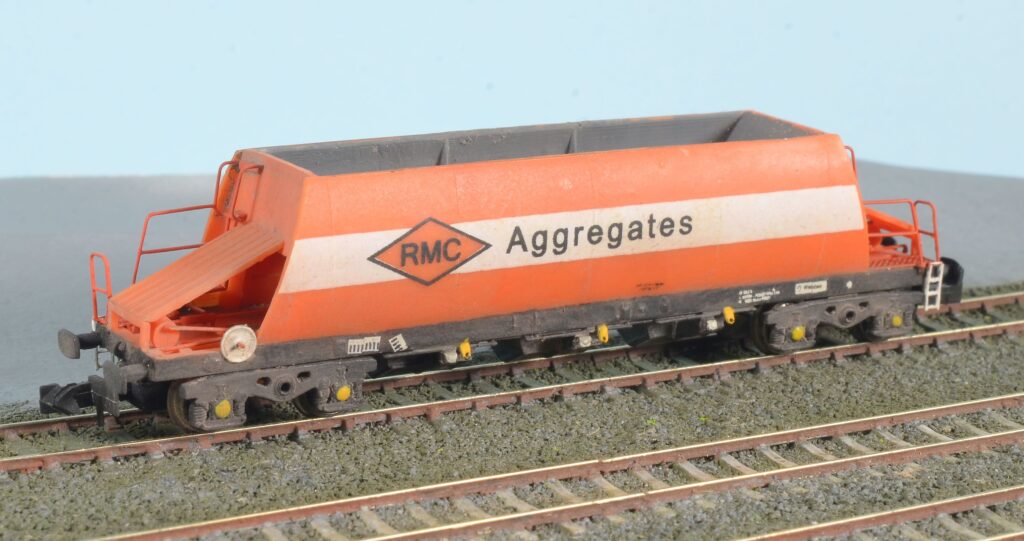
- NGSK0280
- era 8-9
- decals NGST0280
- difficulty advanced
This injection moulded kit, with etched brass details and one piece bogies, will build any of the three variants, suitable transfers for each being included. The model is self coloured in orange, and the white stripe is a transfer or can be painted. Otherwise only the brass details, the solebar and the interior require painting.
13 wagons were built in 1984 to code JG009A for Hall Aggregates, and were used to carry sea-dredged gravel from Newhaven to Crawley and Tolworth. In 1986 a further 24 wagons were built to code JG009B for RMC, which operated on flows nationwide from their base at Peak Forest. In 1996, when the Newhaven traffic ended, the former Hall wagons were brought into the RMC pool at Peak Forest and were modified, refurbished and repainted. Now all 37 wagons are used with other RMC hoppers across the network.
Kit 29: 7-plank Private Owner Wagon
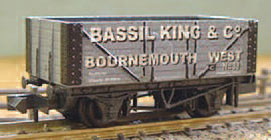
- NGSK0290
- era 2-3
- decals included
- additional decals NGST0230 for BR markings
- Difficulty beginner
This kit is yet another variant of the 1923 RCH wagon design for private owner wagons, this time with 7 planks and no end doors. It is a simple beginners kit using Peco’s 10ft chassis, with several liveries available (and many more possible).